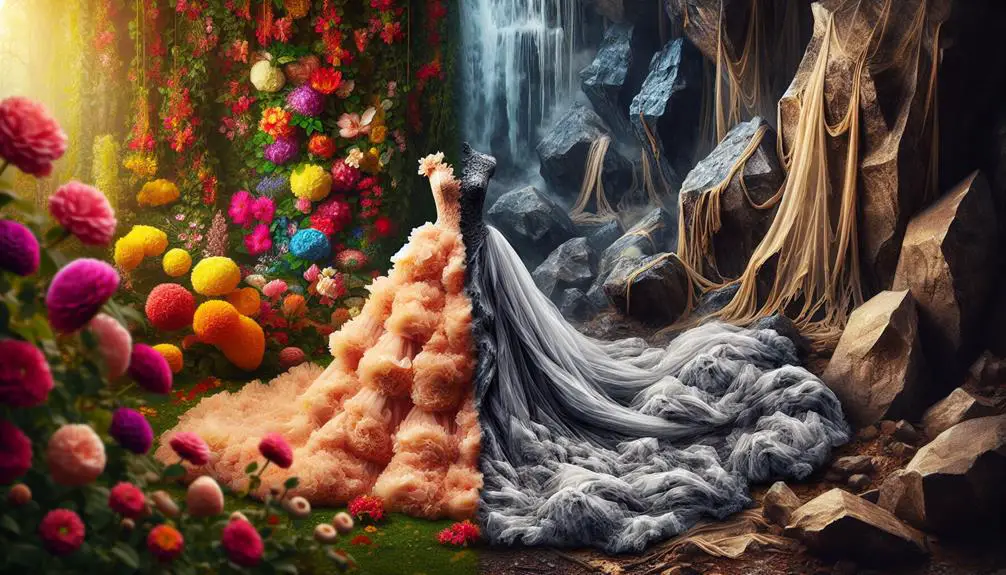Organza's a real beauty in the fabric world, known for its light, airy feel and classy shimmer. It's great for adding a touch of elegance to outfits and décor, especially with its crisp texture that catches the light just right. I've used it for everything from evening dresses to sheer curtains. However, it's a bit high-maintenance. It snags easily and doesn't handle wear and tear well, so you've got to be pretty gentle with it. Plus, if you go for silk rather than synthetic, it can get pricey. But the magical flair it adds? Totally might be worth exploring more about it.
Table of Contents
Key Takeaways
- Organza fabric offers a stunning shimmer and delicate texture, enhancing aesthetic appeal in fashion and decor.
- Due to its transparency, organza requires thoughtful underlayering, limiting its use in some styles.
- Lightweight and breathable, organza is comfortable but prone to snags and requires gentle handling.
- Silk organza is biodegradable, making it environmentally friendlier than polyester, which has a longer degradation period.
- Costs can vary significantly; silk organza is generally more expensive than its synthetic counterparts.
Defining Organza Fabric
Organza is a thin, sheer fabric that's traditionally made from silk. I find its origin pretty fascinating—it comes from a blend of techniques spanning across cultures, primarily in Asia. Originally, silk organza was woven by hand, which gave it a truly unique and luxurious feel. Today, however, it's not just silk on the roster; you'll find organza made from synthetic fibers like polyester and nylon too. This switch makes organza more accessible and affordable, which is great news if you're watching your budget.
Despite its delicate appearance, organza is surprisingly durable thanks to its tight weave. This quality makes it a popular choice in fashion and home decor. It's stiff yet lightweight, creating a structured yet airy feel that's perfect for fancy dresses and sheer curtains alike. But here's the kicker: while it's strong, organza can be a real pain to work with. Its sheerness and slipperiness can challenge even seasoned sewers, and it frays like crazy if you don't handle it right.
Aesthetic Appeal of Organza
I've always been captivated by the stunning shimmer and delicate texture of organza, which adds a touch of elegance to any outfit or decor. This fabric isn't just about looks; it brings a certain magical flair that's hard to mimic with other materials. When you see it, it's like a hint of fairy dust has settled on whatever it's used for, be it dresses, curtains, or fancy table settings.
The way organza catches the light is something else! It can transform from a simple sheer sheet to a radiant, glowing feature with just a flicker of light. This light play isn't just beautiful; it's strategically useful for designers who want to create depth and movement without bulky additions. And let me tell you, nothing beats the subtle rustle of organza when it moves. It's like a soft whisper of luxury.
But, it's not just about being pretty. The texture of organza feels as good as it looks. Despite its delicate appearance, it has a crispness that gives it a rich body, making it a dream to handle for anyone crafting with it. It's one of those materials that you can't help but love working with.
Versatility in Usage
You'd be amazed at just how many ways you can use organza in both fashion and home decor. Let's talk about its versatility! In fashion, this fabric's not just for fancy dresses or wedding gowns. I've seen it used for everything from chic scarves to avant-garde layering pieces in outfits. It adds a touch of elegance and an ethereal quality that other fabrics just can't match.
But it doesn't stop at clothing. In home decor, organza really shines—literally! It's perfect for creating sheer curtain panels that let in natural light while still offering a bit of privacy. And for those of you who love a bit of DIY, you can craft some pretty amazing things with organza. Think table runners, lamp shades, or even decorative flowers. The stiffness of organza makes it easy to work with yet allows for a graceful drape that looks stunning in almost any setting.
Lightweight and Comfortable
While we've explored how versatile organza can be, let's not forget how its lightweight nature makes it incredibly comfortable to wear. When you're slipping into an organza dress, you barely feel the weight. It's like wearing a cloud! This featherlight quality isn't just about comfort; it means you can layer organza without feeling bogged down. I've worn organza skirts under heavier gowns for that extra oomph without adding bulk.
The breathability of organza is another big win. Especially in warmer climates or during summer events, you want a fabric that lets your skin breathe. Organza doesn't cling to your body, allowing air to circulate freely. I've worn it to outdoor weddings and garden parties, and trust me, it's a game-changer. You're not just covered in style; you're cool and collected under the sun.
And when it comes to movement, organza's lightness allows for elegant fluidity. The fabric flows and flutters with every step, making it ideal for dance floors or any setting where you want to move gracefully. It's not just about looking good; it's about feeling free and unrestricted in your outfit.
Transparency and Sheerness
Switching gears to the transparency and sheerness of organza, it's clear this fabric stands out for its delicate and ethereal appearance. The see-through quality isn't just about showing off a bit of skin; it's a real game changer when it comes to adding depth and layering to your outfits. I love how you can pair it with solids to create a mysterious, multi-dimensional look without feeling overwhelmed.
This fabric's sheerness is perfect for those airy, dreamy vibes at weddings or galas. But here's the kicker: it's not just for fancy times. You can totally rock a sheer organza top over a tank for a casual yet chic look. It's all about how you style it. And because it's so light, you don't feel like you're wearing an extra layer, even though you totally are.
However, while the transparency is a pro, it can also be a bit of a con. You've got to think about what you're layering underneath because, trust me, everything shows. It requires a bit of planning to make sure your underlayers are as on point as your organza piece. So, yeah, it's gorgeous, but it does ask for a bit of extra thought!
Durability Concerns
When I talk about organza, I've got to mention it isn't the toughest kid on the block. It's pretty easy to snag and doesn't handle wear and tear all that well.
Susceptible to Snags
Organza's delicate nature means it easily snags, which can be a real pain if you're not careful. I've found that just by wearing jewelry or handling rough surfaces, I can accidentally pull threads out of my organza garments. This fabric isn't just a nightmare around sharp objects; even slightly rough hands can cause damage. So, you've got to handle it with kid gloves.
If you're someone who loves this fabric, it's crucial to be ultra-aware of your surroundings. Avoid brushing past walls or furniture that might catch the fabric. Trust me, once organza snags, it's pretty tough to repair without leaving a noticeable mark. It's all about being gentle and mindful to keep it looking pristine.
Wear and Tear Rate
Beyond the issue of snagging, I've noticed that organza doesn't hold up well to regular wear and tear either. This fabric, while stunning, can be pretty delicate. Here's a quick look at how organza compares to other common fabrics when it comes to durability:
| Fabric Type | Durability | Best Use |
|---|---|---|
| Organza | Low | Occasional wear |
| Cotton | High | Everyday wear |
| Polyester | Medium | Frequent wear |
As you see, organza isn't your go-to for something you'll wear a lot. It's great for those special occasions but think twice if you're planning to use it for an everyday outfit. It just can't take the constant stress.
Maintenance and Care
When it comes to keeping organza looking great, knowing the right cleaning techniques is key.
I'll also share some handy tips on how to store it properly to avoid any damage.
It's all about giving your organza the TLC it needs to last longer and stay beautiful.
Cleaning Techniques
Although organza looks delicate, it's actually pretty straightforward to clean and maintain.
First off, always check the care label. Most organza garments can be hand washed with a mild detergent. I just fill up the sink with cool water, add a bit of soap, and gently swish the fabric around. It's important not to wring it out – that can ruin the shape. Instead, I just lay it flat on a towel, roll the towel up and press out the excess water.
For ironing, I set my iron on a low heat and use a pressing cloth to avoid scorching. It's a bit of work, but keeping organza looking fab isn't too tough!
Storage Recommendations
After mastering the cleaning of organza, it's just as important to store it properly to maintain its beauty.
I've found that the best way to keep my organza looking fab is to hang it up. Folding can lead to nasty creases that are a pain to iron out. So, grab a padded hanger, nothing metal that could rust, and give your organza some room to breathe in your closet. Avoid squishing it between other heavy fabrics.
If you're short on closet space, gently roll the fabric and place it in a dry, breathable bag—avoid plastic like the plague, it traps moisture and can mess with the fabric. Trust me, a little care goes a long way!
Cost Considerations
Let's dive into how much organza fabric can set you back. If you're eyeing this fabric for your next project, you're likely wondering about the hit your wallet's going to take. Well, I've got some insights for you.
First up, organza isn't typically your budget fabric. It's known for its finesse and delicate weave, which often means a higher price tag. You're looking at costs that can vary widely, depending on the type of organza. Silk organza, the crème de la crème of this fabric family, is definitely on the pricier side. We're talking about substantial bucks if you're aiming for top quality. If silk's too steep for your budget, polyester organza offers a more wallet-friendly option. It's cheaper, but hey, you trade off some of that classic sheen and feel.
Don't forget, the price can also jump depending on where you purchase it. High-end fabric stores or designer labels? Yeah, that's going to cost you more. Hunting down deals online or checking out local fabric markets might save some cash. And if you buy in bulk, you might just snag a discount. So, shop smart!
Environmental Impact
So, let's talk about how making organza affects our planet.
It uses a lot of resources, isn't the best at breaking down in nature, and the chemicals involved? Not great.
This stuff matters because it's all about the footprint we leave behind.
Production Resource Consumption
Organza fabric production demands significant resources, impacting the environment notably. Let me break it down for you.
First, there's the water usage. Producing organza, especially silk organza, gulps down a ton of water. It's not just about drinking it up; it's about the whole processing bit.
Then, think energy. The factories spinning this stuff are power hungry. They need loads of electricity to keep the machines running and to process the fabric.
And don't get me started on the chemicals. Whether it's treating the fabric or dyeing it, harsh chemicals are often in the mix, and managing these safely is crucial but challenging.
Biodegradability of Organza
Turning to how organza breaks down in the environment, it's a mixed bag in terms of biodegradability. If you're thinking about silk organza, it's pretty friendly to our planet. Being a natural fiber, silk organza typically breaks down faster, leaving less of a footprint.
However, if we're chatting about synthetic versions, like polyester organza, that's a different story. These materials aren't so quick to say goodbye to our world. They tend to stick around much longer, which isn't great for our planet.
Chemical Usage Impact
The production of organza involves some serious chemical use, which can really mess with our environment. When they make this shiny, crisp fabric, they often use harsh chemicals like formaldehyde and heavy metal salts. These aren't just bad for the planet; they're tough on the workers too, exposing them to harmful conditions. Plus, when organza gets tossed, these chemicals can leach out, contaminating soil and water.
It's not all doom and gloom, though. More manufacturers are catching on and going green with safer, eco-friendly alternatives. But it's a slow shift, and we've gotta keep pushing for it. Choosing organza means looking beyond its beauty and considering its environmental footprint.
Organza in Fashion Trends
Fashion trends often embrace organza for its sheer, ethereal quality that adds a touch of elegance to any outfit. I've seen this fabric pop up everywhere from high fashion runways to the racks of mainstream stores. There's something about its lightness and subtle sheen that designers can't get enough of.
You've probably noticed that organza isn't just for fancy evening wear anymore. Lately, it's been showing up in more casual pieces too, like flowy blouses and even some edgy layered skirts. It's a great way to add a bit of luxury without going overboard. The fabric's versatility is really shown off when you see it included in different types of clothing.
However, it's worth mentioning that organza does require a bit of special care. It's more delicate than your average cotton tee, so you've gotta handle it with care to avoid snags and tears. But honestly, the extra effort is worth it when you see how stunning it looks on. Whether it's adding a graceful flare to a dress or giving a shirt that perfect level of sophistication, organza really knows how to make an outfit shine.
Frequently Asked Questions
Can Organza Be Dyed at Home, and How?
Yes, I can dye organza at home using fabric dye and vinegar. I just soak the fabric in a dye bath, maintain the right temperature, and rinse well. It's a fun DIY project!
Is Organza Fabric Suitable for Winter Clothing?
I wouldn't recommend organza for winter clothing; it's too lightweight and sheer to provide any real warmth. You're better off choosing thicker fabrics like wool or fleece for those chilly months.
Are There Hypoallergenic Types of Organza?
I'm not sure if there are hypoallergenic types of organza. It's typically made from silk or synthetic fibers, which aren't specifically hypoallergenic. You might need to check with manufacturers for any special treatments or versions.
How Does Organza React to Perspiration?
Imagine wearing a cloud that just can't handle a storm; that's organza with sweat. It doesn't absorb moisture well, leaving it less than ideal for hot days or stressful events.
Can Organza Be Used for Upholstery Purposes?
I'd say organza can be used for upholstery, but it's not the best choice. It's delicate and doesn't handle heavy wear well. You'd need to consider where and how you're using it.
- Tetron Fabric for Marine Applications: Durability and Use Cases - June 18, 2025
- Tetron Fabric for Outdoor Furniture: Weather Resistance and Care - June 18, 2025
- Tetron Fabric for Wall Coverings: Style and Application Tips - June 18, 2025






